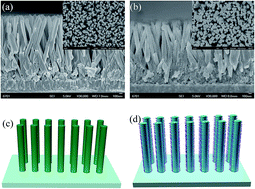Abstract: The semiconductor PbS quantum dots (QDs) were synthesized on TiO2 nanorods (NRs) via a successive ionic layer adsorption and reaction (SILAR) method. The deposition of PbS QDs on the TiO2 NRs could enhance the ability of light absorption and improve the power conversion efficiency of the solar cell. The morphological features, crystal structures, optical properties, photoelectrochemical performances, electron transfer at the TiO2-QDs/electrolyte interface and electron lifetime of the obtained PbS QDs/TiO2 NRs photoelectrodes were characterized and discussed in detail. The results demonstrated that the photoelectrochemical performance of PbS QDs/TiO2 NRs depends on the value of the SILAR cycle number. The highest photoelectric conversion efficiency of 0.77% is achieved at the SILAR cycle number n = 4 under one sun illumination (AM 1.5, 100 mW cm(-2)). The enlarged absorption edges to the visible region and the effective separation of photogenerated electron-hole pairs at the PbS QDs-TiO2 NRs interface are attributed to the promotion of the power conversion efficiency. KeyWords Plus: IONIC-LAYER ADSORPTION; SOLAR-CELLS; ENHANCED PERFORMANCE; NANOTUBE ARRAYS; SIZE; AIR; NANOMATERIALS; PHOTOVOLTAICS; CUINS2; ROUTE Published in RSC ADVANCES, 6 (40):33279-33286; 10.1039/c6ra02543a 2016
|
